Prognostic, Clinicopathological, and Function of Key Cuproptosis Regulator FDX1 in Clear Cell Renal Cell Carcinoma
Abstract
:1. Introduction
2. Materials and Methods
2.1. Data Source
2.2. Evaluation of Cuproptosis-Related Genes Expression
2.3. Evaluation of FDX1 Expression and Prognostic Predictive Power
2.4. Independence of the FDX1 from Clinical Features and Nomogram Construction
2.5. Gene Set Enrichment Analysis (GSEA)
2.6. The Immune Landscape of the FDX1
2.7. Statistical Analysis
3. Results
3.1. Differential Expression of Cuproptosis-Related Genes in ccRCC and Its Prognostic Relevance in Pan-Cancers
3.2. The Key Regulator Cuproptosis FDX1 Is Downregulated in ccRCC
3.3. Correlation between FDX1 Expression and Clinical Features
3.4. The Prognostic Predictive Power of FDX1 Expression in ccRCC
3.5. Stratification Analysis of OS for the FDX1 in ccRCC Patients
3.6. FDX1 Is Independent of Traditional Clinical Characteristics for ccRCC Patients
3.7. Development and Validation of an FDX1-Based Nomogram Model
3.8. Functional Enrichment Analysis and Immune Cells Infiltration Analysis
4. Discussion
5. Conclusions
Supplementary Materials
Author Contributions
Funding
Institutional Review Board Statement
Informed Consent Statement
Data Availability Statement
Conflicts of Interest
References
- Sung, H.; Ferlay, J.; Siegel, R.L.; Laversanne, M.; Soerjomataram, I.; Jemal, A.; Bray, F. Global Cancer Statistics 2020: GLOBOCAN Estimates of Incidence and Mortality Worldwide for 36 Cancers in 185 Countries. CA Cancer J. Clin. 2021, 71, 209–249. [Google Scholar] [CrossRef] [PubMed]
- Barata, P.C.; Rini, B.I. Treatment of renal cell carcinoma: Current status and future directions. CA Cancer J. Clin. 2017, 67, 507–524. [Google Scholar] [CrossRef] [PubMed]
- Jonasch, E.; Walker, C.L.; Rathmell, W.K. Clear cell renal cell carcinoma ontogeny and mechanisms of lethality. Nat. Rev. Nephrol. 2021, 17, 245–261. [Google Scholar] [CrossRef] [PubMed]
- Tsvetkov, P.; Coy, S.; Petrova, B.; Dreishpoon, M.; Verma, A.; Abdusamad, M.; Rossen, J.; Joesch-Cohen, L.; Humeidi, R.; Spangler, R.D.; et al. Copper induces cell death by targeting lipoylated TCA cycle proteins. Science 2022, 375, 1254–1261. [Google Scholar] [CrossRef]
- Ruiz, L.M.; Libedinsky, A.; Elorza, A.A. Role of Copper on Mitochondrial Function and Metabolism. Front. Mol. Biosci. 2021, 8, 711227. [Google Scholar] [CrossRef]
- Oliveri, V. Selective Targeting of Cancer Cells by Copper Ionophores: An Overview. Front. Mol. Biosci. 2022, 9, 841814. [Google Scholar] [CrossRef]
- Steinbrueck, A.; Sedgwick, A.C.; Brewster, J.T.; Yan, K.-C.; Shang, Y.; Knoll, D.M.; Vargas-Zúñiga, G.I.; He, X.-P.; Tian, H.; Sessler, J.L. Transition metal chelators, pro-chelators, and ionophores as small molecule cancer chemotherapeutic agents. Chem. Soc. Rev. 2020, 49, 3726–3747. [Google Scholar] [CrossRef]
- O’Day, S.J.; Eggermont, A.M.; Chiarion-Sileni, V.; Kefford, R.; Grob, J.J.; Mortier, L.; Robert, C.; Schachter, J.; Testori, A.; Mackiewicz, J.; et al. Final results of phase III SYMMETRY study: Randomized, double-blind trial of elesclomol plus paclitaxel versus paclitaxel alone as treatment for chemotherapy-naive patients with advanced melanoma. J. Clin. Oncol. 2013, 31, 1211–1218. [Google Scholar] [CrossRef]
- Tang, Z.; Kang, B.; Li, C.; Chen, T.; Zhang, Z. GEPIA2: An enhanced web server for large-scale expression profiling and interactive analysis. Nucleic Acids Res. 2019, 47, W556–W560. [Google Scholar] [CrossRef]
- Chandrashekar, D.S.; Karthikeyan, S.K.; Korla, P.K.; Patel, H.; Shovon, A.R.; Athar, M.; Netto, G.J.; Qin, Z.S.; Kumar, S.; Manne, U.; et al. UALCAN: An update to the integrated cancer data analysis platform. Neoplasia 2022, 25, 18–27. [Google Scholar] [CrossRef]
- Li, T.; Fan, J.; Wang, B.; Traugh, N.; Chen, Q.; Liu, J.S.; Li, B.; Liu, X.S. TIMER: A Web Server for Comprehensive Analysis of Tumor-Infiltrating Immune Cells. Cancer Res. 2017, 77, e108–e110. [Google Scholar] [CrossRef] [PubMed]
- Camp, R.L.; Dolled-Filhart, M.; Rimm, D.L. X-tile: A new bio-informatics tool for biomarker assessment and outcome-based cut-point optimization. Clin. Cancer Res. 2004, 10, 7252–7259. [Google Scholar] [CrossRef]
- Zhang, D.; Zeng, S.; Hu, X. Identification of a three-long noncoding RNA prognostic model involved competitive endogenous RNA in kidney renal clear cell carcinoma. Cancer Cell Int. 2020, 20, 319. [Google Scholar] [CrossRef]
- Subramanian, A.; Tamayo, P.; Mootha, V.K.; Mukherjee, S.; Ebert, B.L.; Gillette, M.A.; Paulovich, A.; Pomeroy, S.L.; Golub, T.R.; Lander, E.S.; et al. Gene set enrichment analysis: A knowledge-based approach for interpreting genome-wide expression profiles. Proc. Natl. Acad. Sci. USA 2005, 102, 15545–15550. [Google Scholar] [CrossRef]
- Therneau, T. Survival: Survival Analysis, Including Penalised Likelihood. 2010. Available online: https://github.com/therneau/survival (accessed on 30 April 2022).
- Heagerty, P.J.; Lumley, T.; Pepe, M.S. Time-dependent ROC curves for censored survival data and a diagnostic marker. Biometrics 2000, 56, 337–344. [Google Scholar] [CrossRef]
- Zhang, Z.; Kattan, M.W. Drawing Nomograms with R: Applications to categorical outcome and survival data. Ann. Transl. Med. 2017, 5, 211. [Google Scholar] [CrossRef] [PubMed]
- Zhang, M.; Zhang, X.; Yu, M.; Zhang, W.; Zhang, D.; Zeng, S.; Wang, X.; Hu, X. A Novel Ferroptosis-Related Gene Model for Overall Survival Predictions of Bladder Urothelial Carcinoma Patients. Front. Oncol. 2021, 11, 698856. [Google Scholar] [CrossRef] [PubMed]
- Vickers, A.J.; Elkin, E.B. Decision curve analysis: A novel method for evaluating prediction models. Med. Decis. Mak. 2006, 26, 565–574. [Google Scholar] [CrossRef] [PubMed]
- Ljungberg, B.; Albiges, L.; Abu-Ghanem, Y.; Bedke, J.; Capitanio, U.; Dabestani, S.; Fernández-Pello, S.; Giles, R.H.; Hofmann, F.; Hora, M.; et al. European Association of Urology Guidelines on Renal Cell Carcinoma: The 2022 Update. Eur. Urol. 2022, 82, 399–410. [Google Scholar] [CrossRef]
- Li, S.R.; Bu, L.L.; Cai, L. Cuproptosis: Lipoylated TCA cycle proteins-mediated novel cell death pathway. Signal Transduct. Target. Ther. 2022, 7, 158. [Google Scholar] [CrossRef]
- Ge, E.J.; Bush, A.I.; Casini, A.; Cobine, P.A.; Cross, J.R.; DeNicola, G.M.; Dou, Q.P.; Franz, K.J.; Gohil, V.M.; Gupta, S.; et al. Connecting copper and cancer: From transition metal signalling to metalloplasia. Nat. Rev. Cancer 2022, 22, 102–113. [Google Scholar] [CrossRef] [PubMed]
- Ackerman, C.M.; Lee, S.; Chang, C.J. Analytical Methods for Imaging Metals in Biology: From Transition Metal Metabolism to Transition Metal Signaling. Anal. Chem. 2017, 89, 22–41. [Google Scholar] [CrossRef] [PubMed]
- Hare, D.J.; New, E.J.; de Jonge, M.D.; McColl, G. Imaging metals in biology: Balancing sensitivity, selectivity and spatial resolution. Chem. Soc. Rev. 2015, 44, 5941–5958. [Google Scholar] [CrossRef] [PubMed]
- Cobine, P.A.; Moore, S.A.; Leary, S.C. Getting out what you put in: Copper in mitochondria and its impacts on human disease. Biochim. Biophys. Acta Mol. Cell Res. 2021, 1868, 118867. [Google Scholar] [CrossRef]
- Gudekar, N.; Shanbhag, V.; Wang, Y.; Ralle, M.; Weisman, G.A.; Petris, M.J. Metallothioneins regulate ATP7A trafficking and control cell viability during copper deficiency and excess. Sci. Rep. 2020, 10, 7856. [Google Scholar] [CrossRef] [PubMed]
- Kaler, S.G. ATP7A-related copper transport diseases-emerging concepts and future trends. Nat. Rev. Neurol. 2011, 7, 15–29. [Google Scholar] [CrossRef]
- Tsvetkov, P.; Detappe, A.; Cai, K.; Keys, H.R.; Brune, Z.; Ying, W.; Thiru, P.; Reidy, M.; Kugener, G.; Rossen, J.; et al. Mitochondrial metabolism promotes adaptation to proteotoxic stress. Nat. Chem. Biol. 2019, 15, 681–689. [Google Scholar] [CrossRef]
- Zhang, Z.; Ma, Y.; Guo, X.; Du, Y.; Zhu, Q.; Wang, X.; Duan, C. FDX1 can Impact the Prognosis and Mediate the Metabolism of Lung Adenocarcinoma. Front. Pharmacol. 2021, 12, 749134. [Google Scholar] [CrossRef]
- Bian, Z.; Fan, R.; Xie, L. A Novel Cuproptosis-Related Prognostic Gene Signature and Validation of Differential Expression in Clear Cell Renal Cell Carcinoma. Genes 2022, 13, 851. [Google Scholar] [CrossRef]
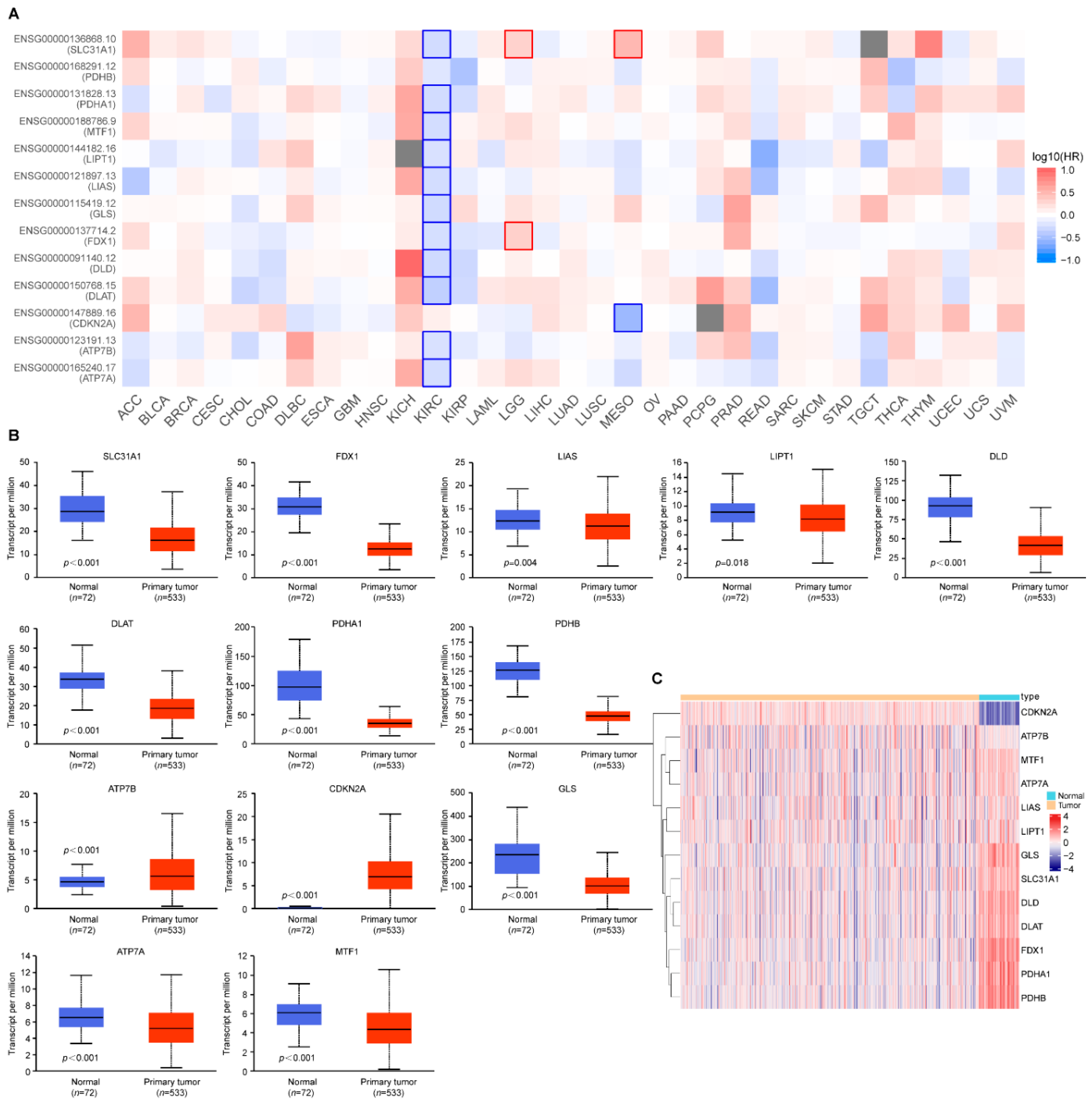
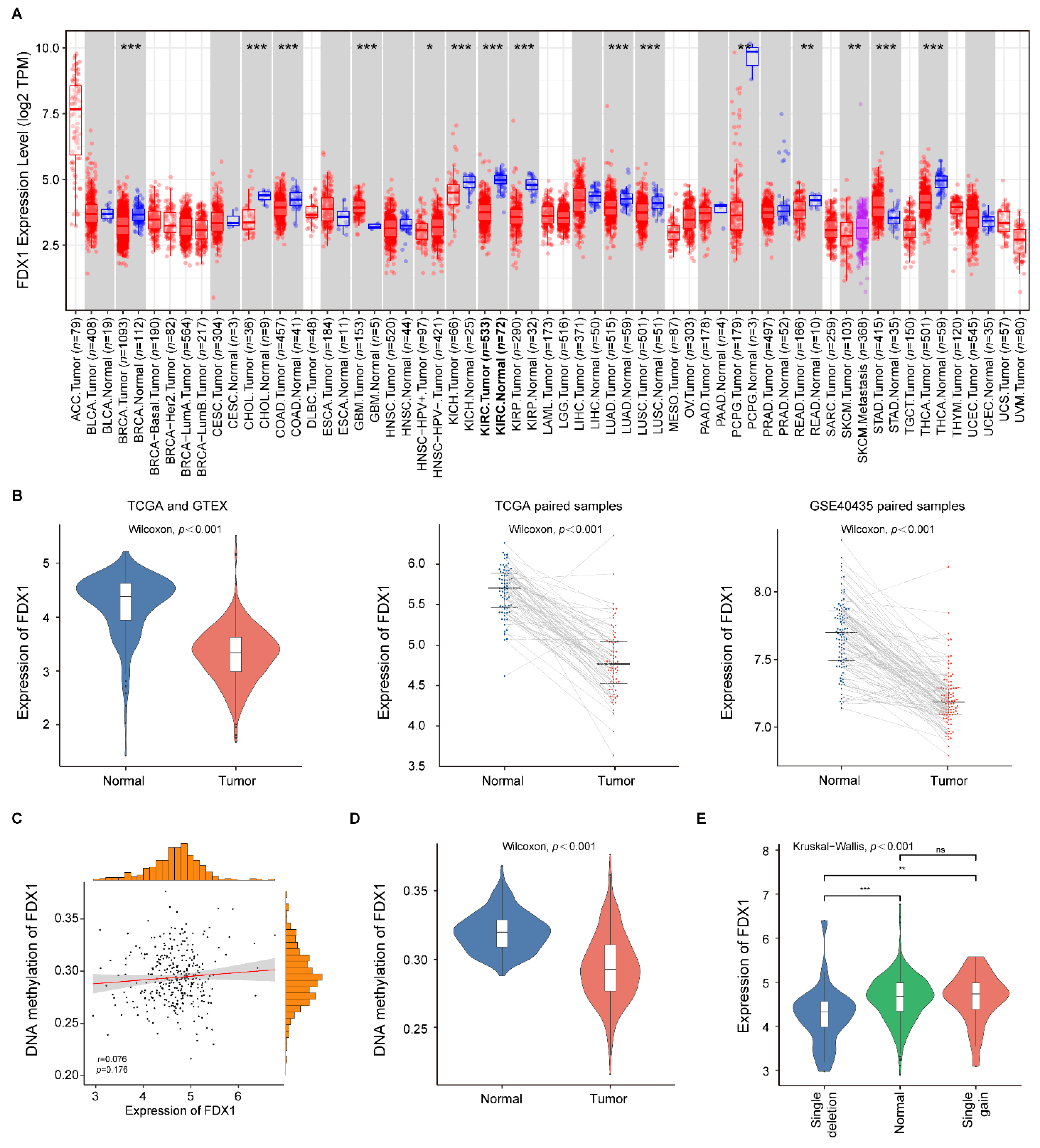
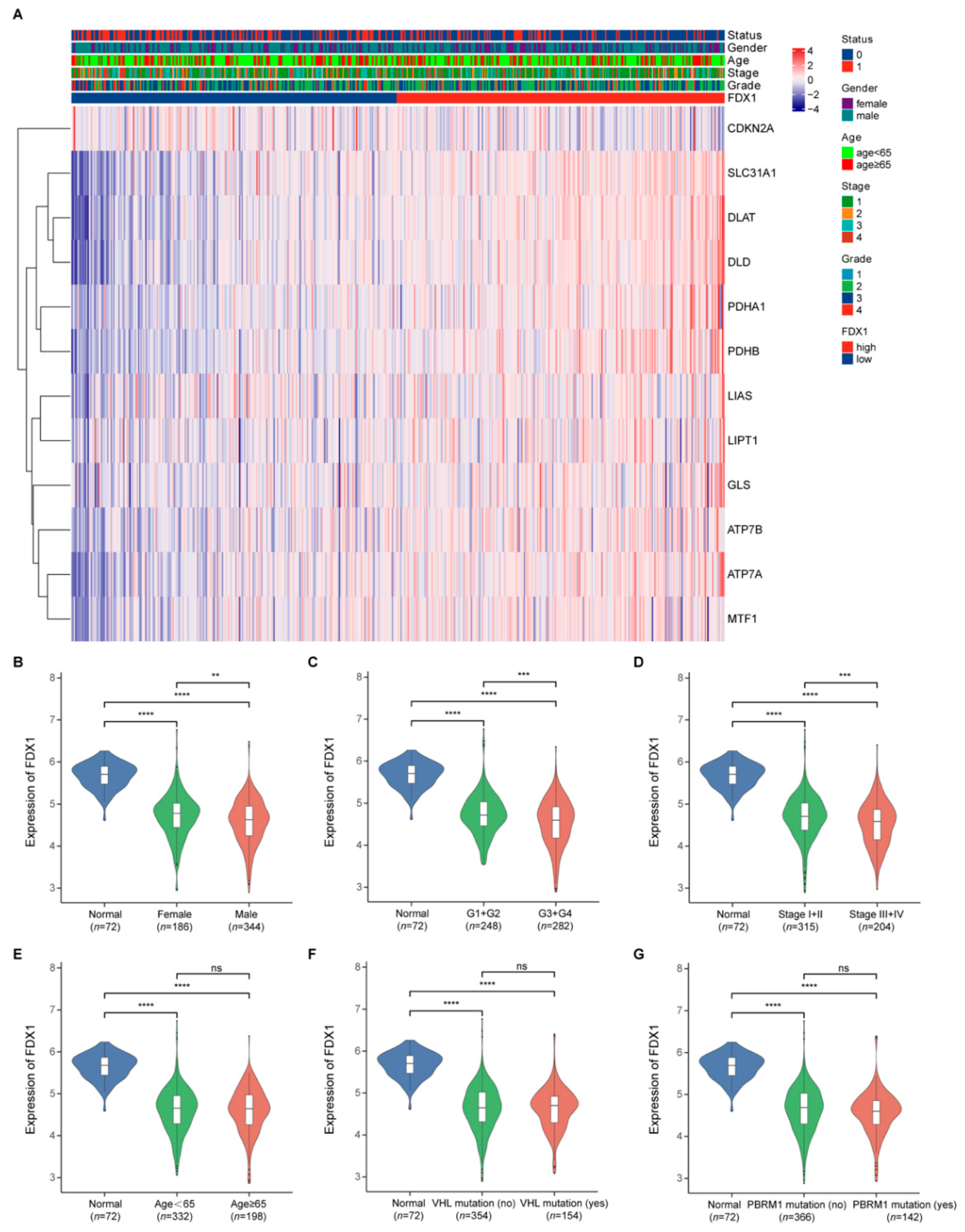
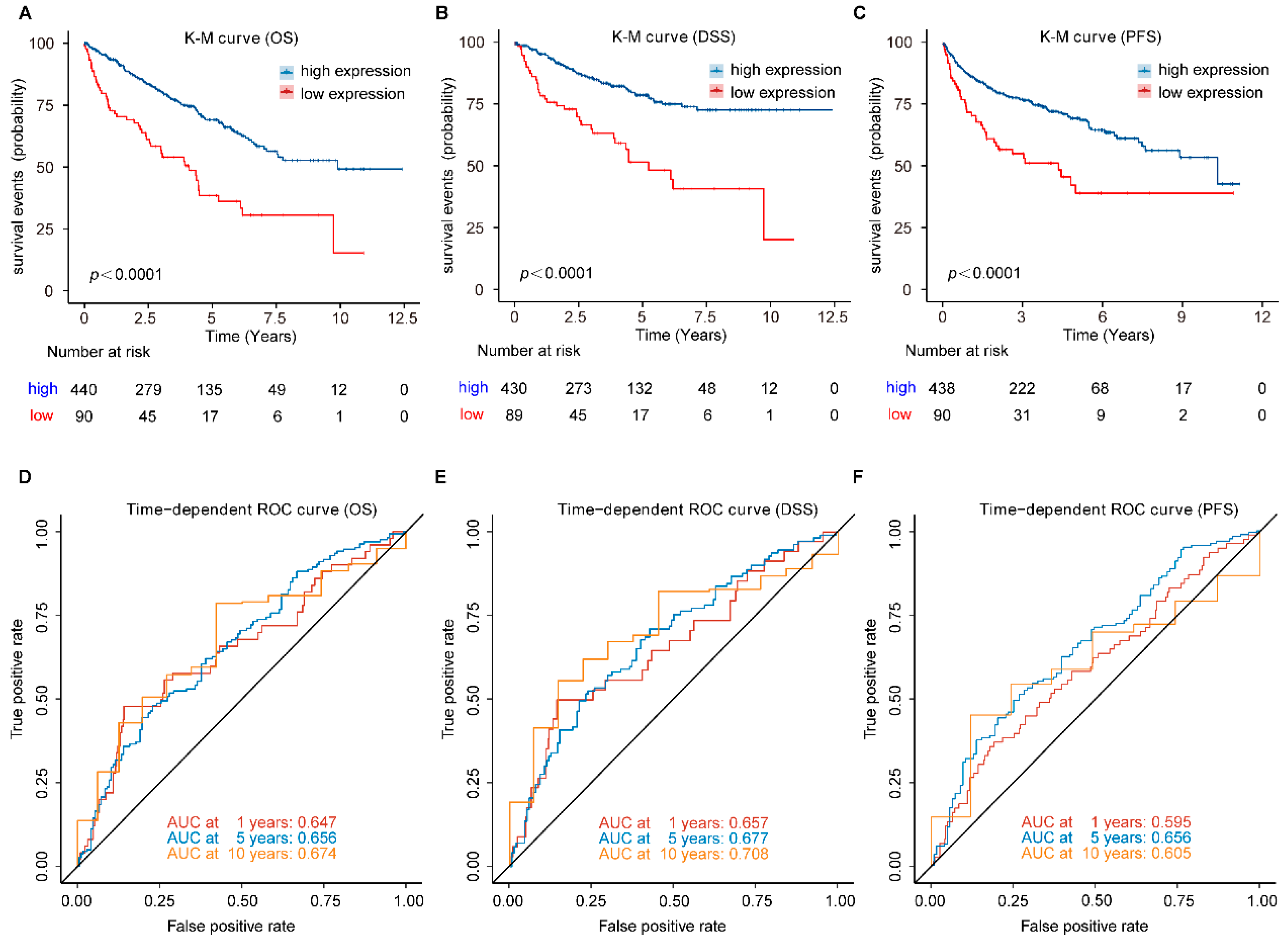
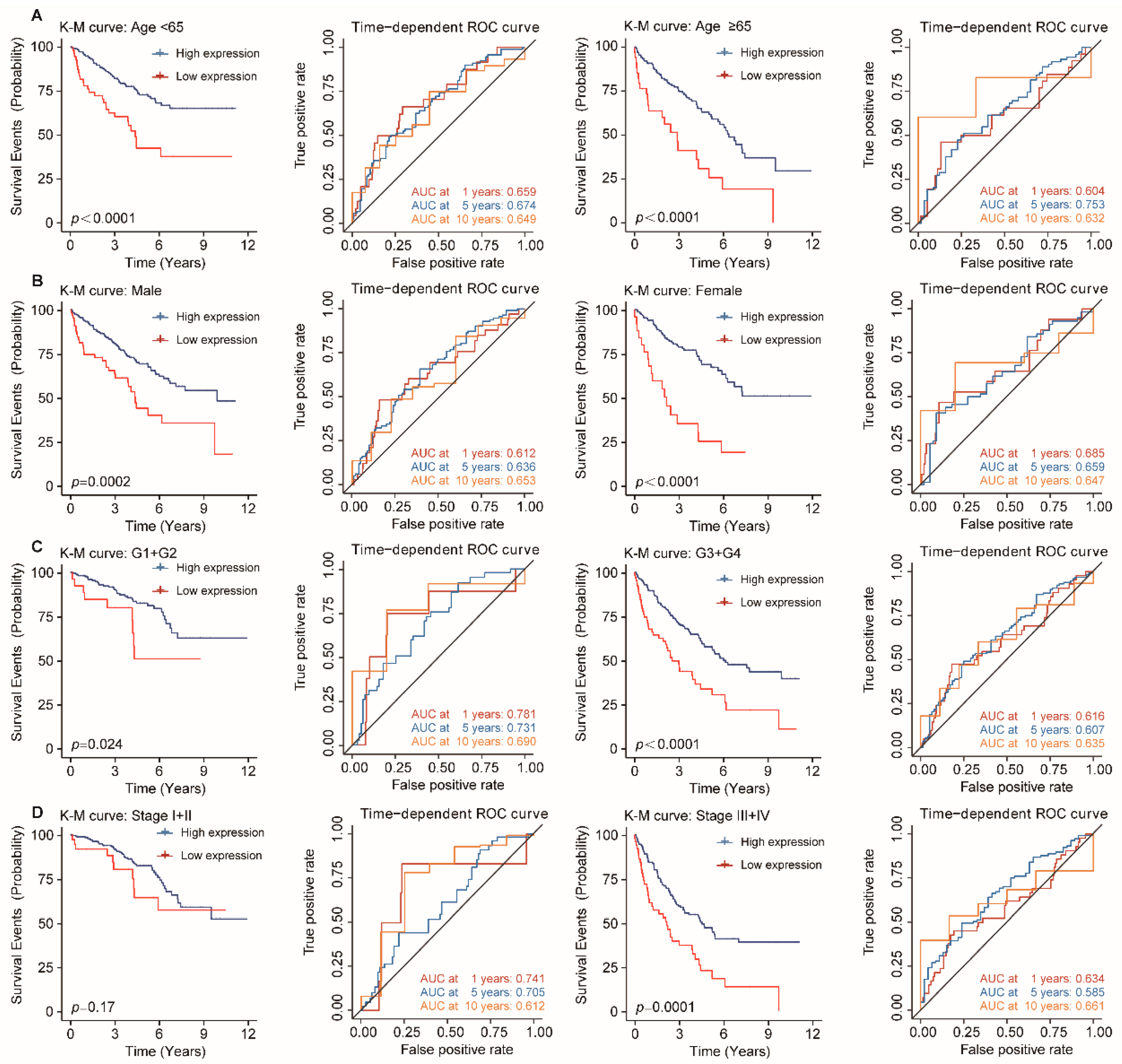
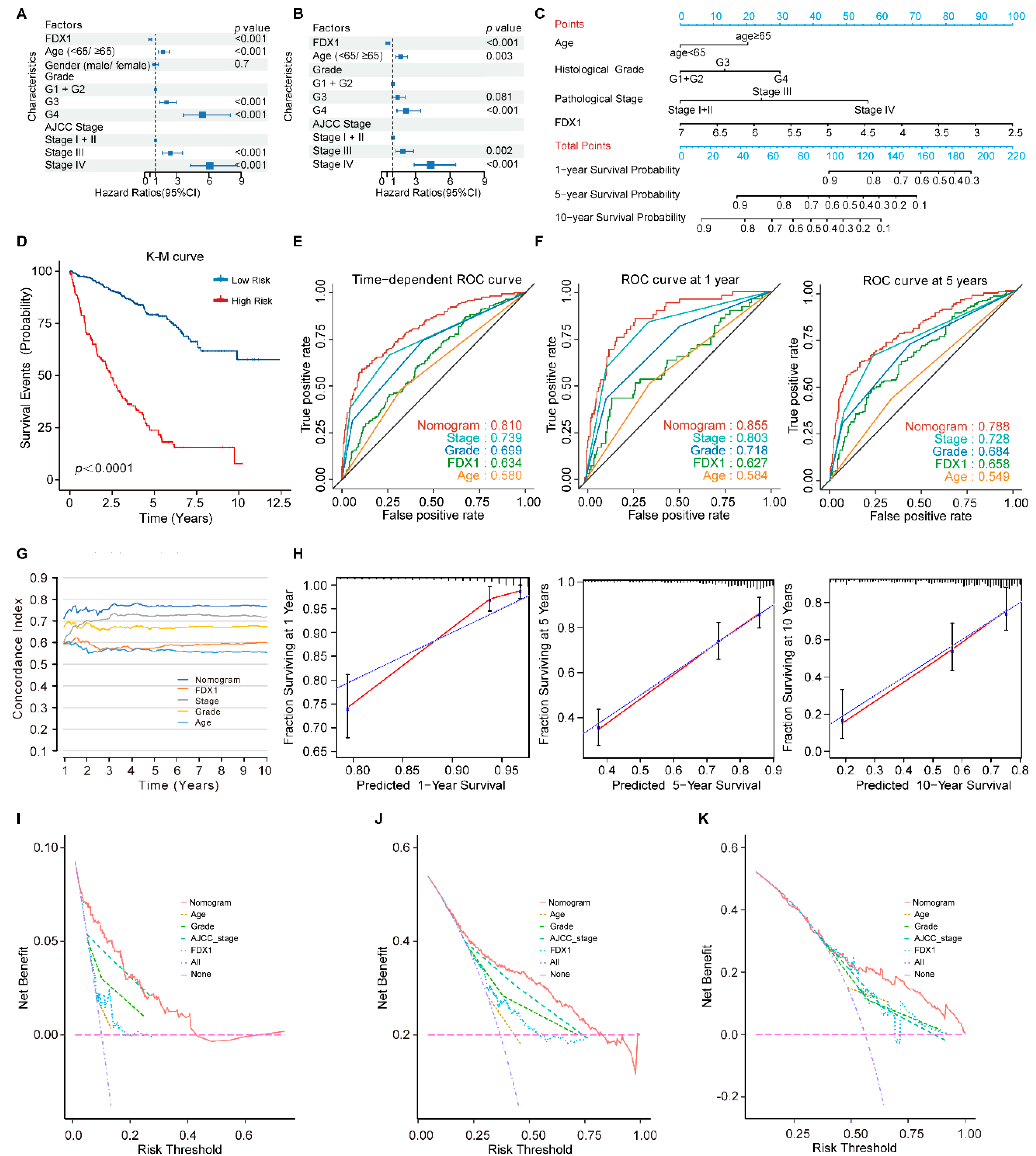
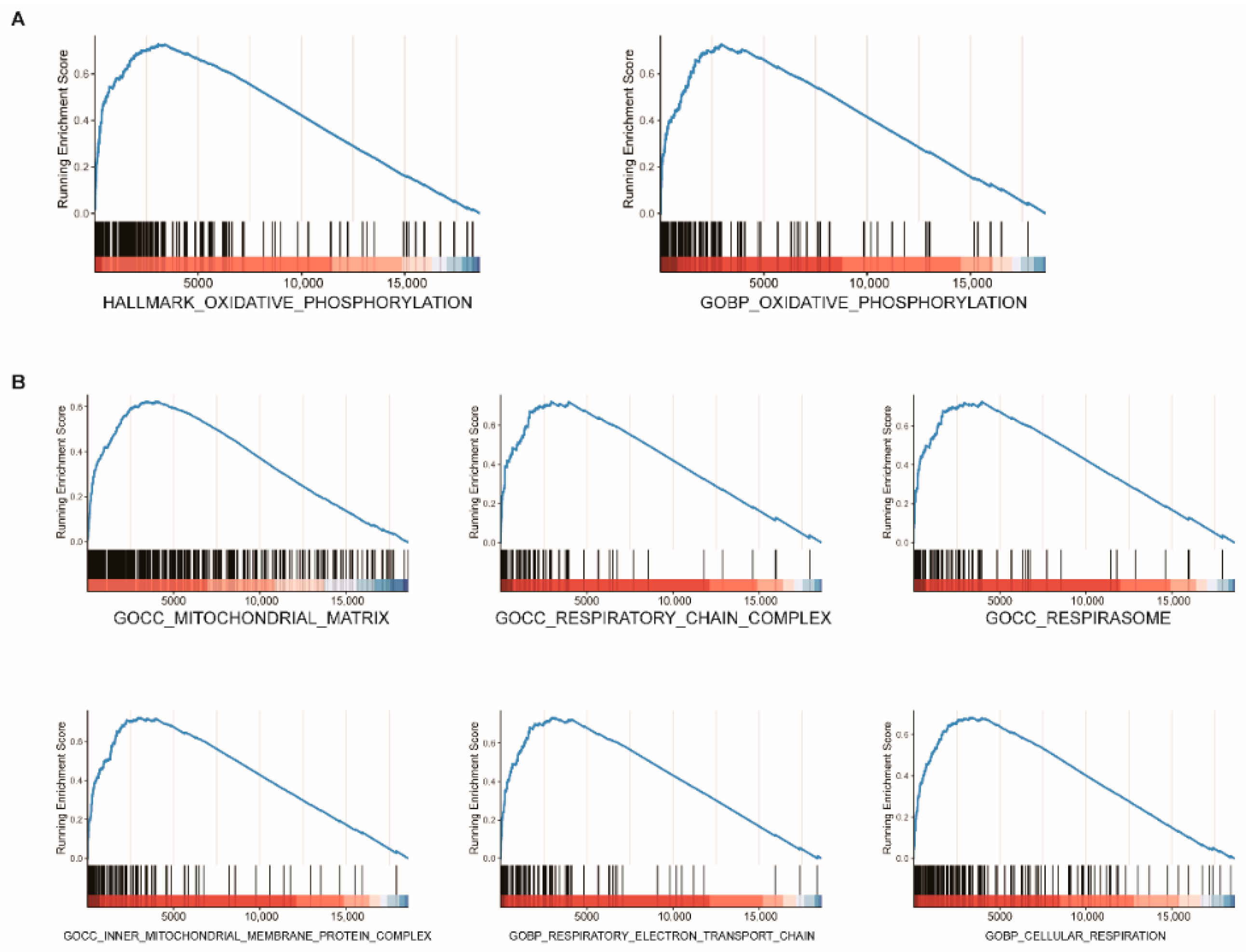
| Characteristics | Total (N) | FDX1 Expression | |
|---|---|---|---|
| OR (95% CI) | p Value | ||
| Age (<65 vs. ≥65) | 530 | 0.96 (0.69–1.34) | 0.816 |
| Gender (female vs. male) | 530 | 1.62 (1.15–2.29) | 0.006 |
| Grade | 530 | ||
| G1 + G2 | Reference | ||
| G3 + G4 | 0.48 (0.34–0.67) | <0.001 | |
| AJCC Stage | 519 | ||
| Stage I + II | Reference | ||
| Stage III + IV | 0.57 (0.41–0.81) | <0.001 | |
| VHL_mutated (yes vs. no) | 508 | 0.99 (0.7–1.41) | 0.967 |
| PBRM1_mutated (yes vs. no) | 508 | 0.76 (0.53–1.09) | 0.136 |
| Characteristics | Overall Survival | ||
|---|---|---|---|
| Total (N) | HR (95% CI) | p Value | |
| Age | |||
| <65 | 332 | 2.58 (1.65–4.04) | <0.0001 |
| ≥65 | 198 | 2.66 (1.63–4.35) | <0.0001 |
| Gender | |||
| male | 344 | 2.15 (1.42–3.24) | 0.0002 |
| female | 186 | 3.7 (2.13–6.41) | <0.0001 |
| Grade | |||
| G1 + G2 | 248 | 2.28 (1.09–4.74) | 0.024 |
| G3 + G4 | 282 | 2.22 (1.53–3.22) | <0.0001 |
| AJCC Stage | |||
| Stage I + II | 315 | 1.6 (0.81–3.17) | 0.17 |
| Stage III + IV | 204 | 2.13 (1.44–3.15) | 0.00011 |
| Factors | Univariate | Multivariate | ||
|---|---|---|---|---|
| HR (95% CI) | p Value | HR (95% CI) | p Value | |
| FDX1 | 0.489 (0.372–0.639) | <0.001 | 0.562 (0.422–0.749) | <0.001 |
| Age (<65/≥65) | 1.714 (1.272–2.309) | <0.001 | 1.693 (1.252–2.289) | 0.003 |
| Gender (male/female) | 0.941 (0.691–1.283) | 0.7 | ||
| Grade | ||||
| G1 + G2 | 1 | 1 | ||
| G3 | 2.031 (1.398–2.95) | <0.001 | 1.414 (0.958–2.085) | 0.081 |
| G4 | 5.38 (3.617–8.002) | <0.001 | 2.174 (1.375–3.436) | <0.001 |
| AJCC Stage | ||||
| Stage I + II | 1 | 1 | ||
| Stage III | 2.41 (1.641–3.539) | <0.001 | 1.884 (1.263–2.809) | 0.002 |
| Stage IV | 6.073 (4.256–8.664) | <0.001 | 4.325 (2.878–6.501) | <0.001 |
Publisher’s Note: MDPI stays neutral with regard to jurisdictional claims in published maps and institutional affiliations. |
© 2022 by the authors. Licensee MDPI, Basel, Switzerland. This article is an open access article distributed under the terms and conditions of the Creative Commons Attribution (CC BY) license (https://creativecommons.org/licenses/by/4.0/).
Share and Cite
Zeng, S.; Zhang, H.; Zhang, D.; Hu, X.; Song, L. Prognostic, Clinicopathological, and Function of Key Cuproptosis Regulator FDX1 in Clear Cell Renal Cell Carcinoma. Genes 2022, 13, 1725. https://doi.org/10.3390/genes13101725
Zeng S, Zhang H, Zhang D, Hu X, Song L. Prognostic, Clinicopathological, and Function of Key Cuproptosis Regulator FDX1 in Clear Cell Renal Cell Carcinoma. Genes. 2022; 13(10):1725. https://doi.org/10.3390/genes13101725
Chicago/Turabian StyleZeng, Song, He Zhang, Di Zhang, Xiaopeng Hu, and Liming Song. 2022. "Prognostic, Clinicopathological, and Function of Key Cuproptosis Regulator FDX1 in Clear Cell Renal Cell Carcinoma" Genes 13, no. 10: 1725. https://doi.org/10.3390/genes13101725
APA StyleZeng, S., Zhang, H., Zhang, D., Hu, X., & Song, L. (2022). Prognostic, Clinicopathological, and Function of Key Cuproptosis Regulator FDX1 in Clear Cell Renal Cell Carcinoma. Genes, 13(10), 1725. https://doi.org/10.3390/genes13101725







